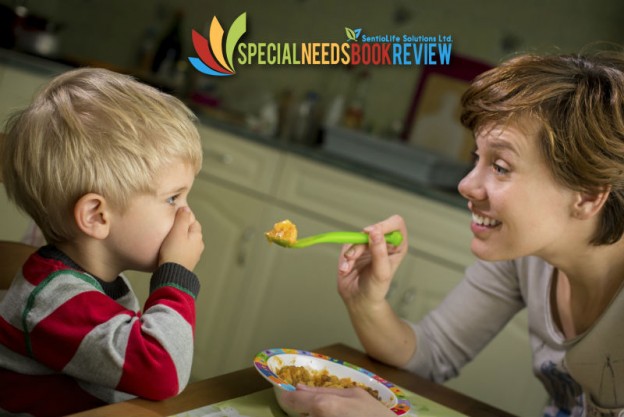
Picky Eating Problems? Four Books to Make Every Bite Count
March is National Nutrition Month; therefore, I have books to recommend that will make your mealtimes happier family occasions and, hopefully, help your kids, tweens, and teens try new foods and eat more nutritious meals and snacks. For parents with picky eaters, the stress of getting their children to eat a balanced diet never ceases but the wave of information during Nutrition Month is a good time to start making changes. The strategies found in the books below will help with sensory issues regarding food textures, food temperatures, the look of food, the smell of food and more. These books will give you the tips that will “make every bite count”!1. The Pocket Occupational Therapist for Families of Children with Special Needs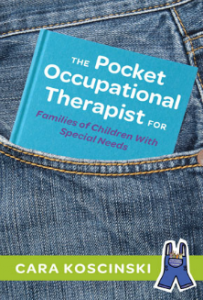
by Cara Koscinski
Cara Koscinski has her Master’s degree in Occupational Therapy and has been an occupational therapist for over 15 years. Ms. Koscinski is also a parent to children with autism spectrum, eosinophilic and sensory processing disorders. She has used her experience and knowledge gained from being a mom of children with special needs and her studies and work experience as an occupational therapist to come up with a wonderful guide book.
This handy, well organized resource book of 144 pages has an index and a detailed Table of Contents with numerous sub-headings in each chapter. This format makes it easy to find the information you are looking for. For example in the chapter Feeding and Oral-Motor (Muscles of the Mouth), there are thirteen sub-headings. Usually they are in the form of a question. Here are a few: Feeding and Oral-Motor
- Food Aversion
- Why does my child eat only one or two foods?
- How can I tell if my child is having difficulty with eating?
- Who should be involved in the “feeding team”?
- Why does my child drool?
- How do I help my child to strengthen her mouth/oral muscles?
Cara Koscinski's suggestions are easy to implement, inexpensive, and do not require a lot of equipment or therapy tools. Read the complete review here.
2. Special Diets for Special Kids, Volumes 1 and 2 Combined
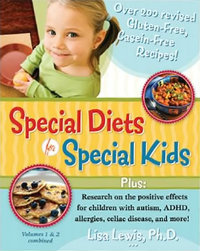
by Lisa Lewis, Ph.D.
Special Diets for Special Kids, Volumes 1 and 2 Combined : Over 200 REVISED and NEW gluten-free casein-free recipes, plus research on the positive effects for children with autism, ADHD, allergies, celiac disease, and more! is much more than an ordinary cook book. This book has 376 pages the size of a regular sheet of paper. This high quality books is worth every penny! The balance of text, photos and blank space is pleasing to the eyes. It is very well designed and user-friendly. Most pages have colorful photos of the completed dish.
Dr. Lewis has compiled over 200 revised and NEW gluten-free, casein-free recipes. She also includes a free CD of printable recipes in a handy pouch in the back cover. In the Table of Contents the recipes are grouped together in 10 chapters with subheadings and are also very easy to find in the detailed index. Most recipes have a colored photo and a short, entertaining, and usually educational anecdote at the beginning.
She has both the traditional way the dish was made and the variations that can be made to accommodate dietary needs or individual preferences. When a new or different ingredient is listed, Lisa includes where best to buy it, how to keep or store it, and information about it. With each recipe the yield to expect is clearly indicated at the end of each recipe.
Moreover, because Dr. Lewis knows that with our picky eaters we must make every bite count, she has notes with many of the recipes to remind parents how they can pack more nutrients by blending in veggies, fruits, etc. that the child will never notice. Lisa’s favourite “vehicle” for hidden nutrients is muffins. She shows you how to sneak in extra eggs and nuts for protein, carrots for bulk, fiber, and vitamins, molasses for iron, calcium powder and ground flax seeds to bump up the nutrition.
High-five Dr. Lewis and all responsible for this winning combination of recipes and the information parents want to know about the foods they prepare for their family. Read the complete review here.
3. Happy Mealtimes with Happy Kids: How to Teach Your Child About the Joy of Food
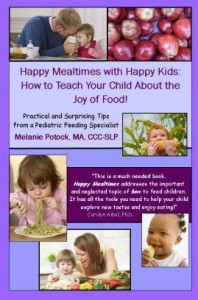
by Melanie Potock , MA, CCC-SLP
Melanie Potock is a speech language pathologist, a feeding specialist, and a mom herself. Melanie wrote this helpful, easy-to-read guidebook filled with parenting tips for busy parents in mind. When you turn the last page, you will surely be motivated and have the knowhow to make your family mealtimes happier ones.
Her advice is educational, functional and fun! Her twelve years’ experience in the field shows through by the different coping strategies she offers. She wisely counsels to seek professional help for serious eating issues.
Melanie has found the perfect recipe to deliver her message about helping children to eat a variety of healthy foods with an independent, joyful and healthy approach to mealtimes. The author also points out how these same strategies can be used in other areas of parenting.
Some of the features of this book:
- The book is short; therefore, it motivates a harried, hurried parent to buy and read it.
- Each of the fifteen chapters begins with an anecdote about a real incident in Melanie’s practice as a Pediatric Feeding Specialist.
- Then seamlessly Melanie delves deeper in the chapter’s topic teaching valuable lessons to parents to make life easier and mealtimes happier for the whole family.
- Each chapter ends with a bullet format synopsis of tips parents will be able to find easily and reread.
- In the middle of a chapter, if Melanie feels a reader might want more information on a topic, she gives links to a helpful book or resource.
- Then at the end, in the 5 page section Resources, the resources are again listed under categories in alphabetical order
4. The Survival Guide for Kids with Autism Spectrum Disorders and Their Parents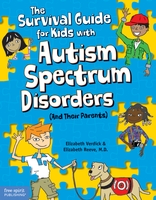
by Elizabeth Verdick and Elizabeth Reeve M.D.
The Survival Guide for Kids with Autism has a kid-friendly format featuring brightly colored text and cartoon drawings. Nick Kobyluch’s entertaining illustrations are perfect for the tweens and teens who will be sharing this book, preferably with an adult who can answer questions as they read along.
The 23 chapter book has 234 pages that are divided into three parts and it has an index. It is a friendly, thorough handbook for children on the autism spectrum, plus their parents. This book addresses the big questions kids ask and provides strategies for communicating, making friends, and succeeding in school. It includes sections on brain and body basics, symptom management, exercise, diet, hygiene, relaxation, sleep, toileting, and “stims.” Special emphasis is placed on helping children handle intense emotions, all with the help of their team of caregivers.
The chapter entitled “Feed Your Body” is excellent as is the entire book. The reader will learn about how to get enough nutrients, how to deal with sensitivities, how to avoid dyes, chemicals, and sweeteners, and how to choose healthy foods every day.
I highly recommend this book for many reasons. The content is wonderful and the book’s eye-catching features will appeal to kids. Color is used everywhere… for chapter titles and subtitles, for the background of personal stories and the top of each page, in charts and lists, illustrations and photos, etc. Also font style and size varies. You find bold letters, colorful letters, letters in italic, and letters that look like a child’s printing!
There is never a dull page or a long section of text to read. The text is broken up with bulleted information, quotes from kids, red star busts suggestions, “Take a Look” bright yellow sections, “Thinking Clouds”, and visual presentation of words on various topics.
Congratulations to the team that wrote and designed such a fine and much needed guide book for kids with autism spectrum disorders and their parents. Read the complete review here.



